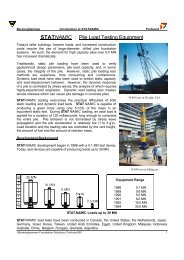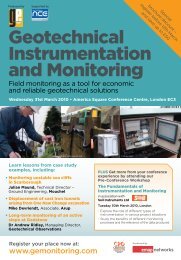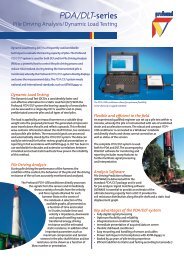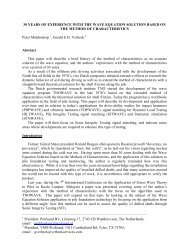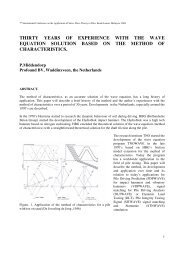When to apply DLT and Statnamic.pdf - Profound BV
When to apply DLT and Statnamic.pdf - Profound BV
When to apply DLT and Statnamic.pdf - Profound BV
You also want an ePaper? Increase the reach of your titles
YUMPU automatically turns print PDFs into web optimized ePapers that Google loves.
2nd <strong>Statnamic</strong> Seminat, Tokyo, 1998 6<br />
of piles tested in one day are in the same range as with <strong>DLT</strong>. STN can be even more efficient when the<br />
loading device <strong>and</strong> hydraulic catch mechanism are placed on crawlers. An epoxy or grout cement is used<br />
<strong>to</strong> smoothen the pile head surface <strong>to</strong> prevent stress concentrations during push loading.<br />
Table 1. Preferences for <strong>DLT</strong> or STN with respect <strong>to</strong> economy for cast in situ piles<br />
Capacity<br />
<strong>DLT</strong> with drop<br />
hammer<br />
Cast in situ piles<br />
STN device with<br />
gravel catch<br />
mechanism<br />
STN device with<br />
hydraulic catch<br />
mechanism<br />
Up <strong>to</strong> 4 MN **** *** ****<br />
4 MN <strong>to</strong> 10MN **** *** not applicable<br />
10MN <strong>to</strong> 30MN **** *** not applicable<br />
more than 30MN **** *** not applicable<br />
***** = economic<br />
* = not economic<br />
• Chance of pile damage<br />
With <strong>DLT</strong> the load on the pile head is introduced by an impacting ram. <strong>When</strong> the ram is not properly<br />
guided <strong>and</strong> hits the pile in an eccentric way, bending stresses will occur <strong>and</strong> result in excessive<br />
compression <strong>and</strong>/or tension stresses which can damage the pile.<br />
Most cast in situ piles need considerably more displacement <strong>to</strong> mobilize the ultimate capacity than driven<br />
piles. This softer response will easily generate tension waves. Cast in situ piles are not designed <strong>to</strong><br />
withst<strong>and</strong> high tension stresses. As soon as allowable tension stress levels are reached the impact energy<br />
has <strong>to</strong> be reduced <strong>to</strong> prevent pile damage. As a result, <strong>DLT</strong> has <strong>to</strong> be s<strong>to</strong>pped at a stage where full<br />
capacity has not yet been mobilized.<br />
With STN the duration of the loading is long enough <strong>to</strong> keep the pile is under constant compression <strong>and</strong><br />
tension stresses will not occur. To prevent bending stresses the pis<strong>to</strong>n of the statnamic device is installed<br />
exactly on or near the center of the pile head cross section. The launching of the reaction mass, <strong>and</strong> the<br />
resulting push load start from the center of the pile.<br />
The application of <strong>DLT</strong> <strong>and</strong> STN on<br />
precast driven piles<br />
For precast driven piles both <strong>DLT</strong> <strong>and</strong> STN are performed<br />
after a setup period after pile installation. This allows the soil<br />
<strong>to</strong> recover from driving induced disturbances like pore water<br />
pressure. In most cases the soil will regain strength during the<br />
setup period.<br />
For <strong>DLT</strong> strain <strong>and</strong> acceleration transducers are mounted on<br />
the pile shaft near the pile head. The load displacement<br />
behavior is calculated by signal matching.<br />
For STN the load displacement behavior is calculated in most<br />
cases by the Unloading Point Method, however signal<br />
matching techniques are also applied.<br />
Fig 9. Dynamic load test on a precast<br />
pile



